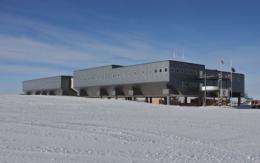South Pole website celebrates a century of science

A century ago, two groups of explorers crossed the Antarctic continent, competing for the distinction of being the first to stand at the geographic South Pole. Norwegian native Roald Amundsen and his men won that race. His British rival, Robert Falcon Scott, and his party arrived roughly a month later, only to perish on the way back to their base camp.
To mark this centennial and the century of scientific exploration of Antarctica that began with these expeditions, the National Science Foundation (NSF) revised and updated its award-winning website: "U.S. South Pole Station: Supporting Science."
The site, which was honored by the National Association of Government Communicators when it first launched, has been updated to reflect the dedication in 2008 of the latest Amundsen-Scott South Pole station. This state-of-the-art science-support facility consists of two massive scientific experiments: the 10-meter South Pole Telescope--the largest radiotelecsope ever built in Antarctica--and the IceCube Neutrino Observatory--a device a kilometer on a side built into the ice sheet below the station.
The revamped website traces the history of human habitation of the South Pole, from Amundsen's pyramidal tent through the three successive U.S. scientific stations that have occupied the Pole since the 1950s.
The site also includes new Education and Outreach content that reflects NSF's mission as an agency that supports both scientific research and science-educationIncluded are a recorded lecture about the Amundsen-Scott rivalry by Ross MacPhee, who curated Race to the End of the Earth, an NSF-funded exhibit at New York's American Museum of Natural History.
It also includes a question and answer session with Pulitzer-Prize Winner Ed Larson, a participant in NSF's Antarctic Artists & Writers Program and the author of An Empire of Ice: Scott, Shackleton, and the Heroic Age of Antarctic Science.
In addition, the site contains downloadable copies of a cross-section poster of the elevated South Pole station as well as graphics that outline the challenges, both technological and physical, of building the station.
The website may be found on the National Science Foundation's website.
Provided by National Science Foundation















